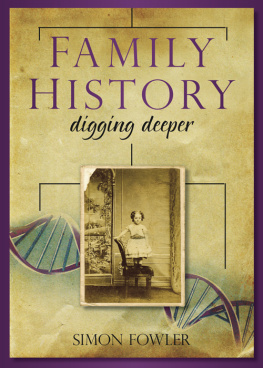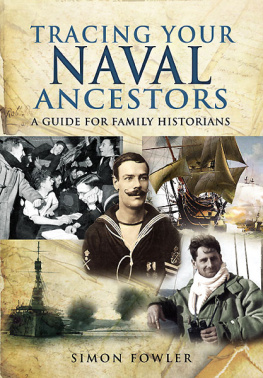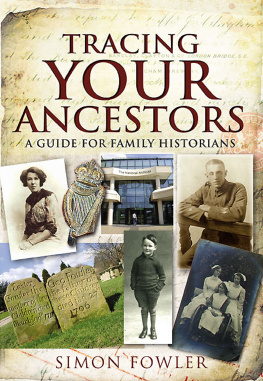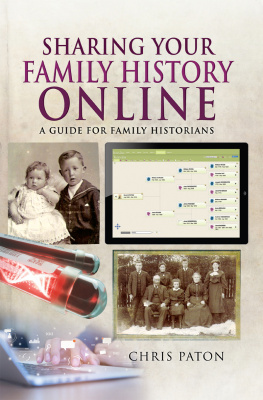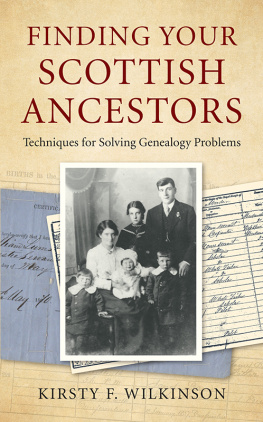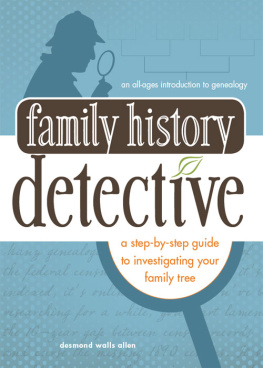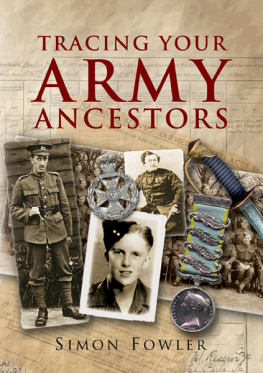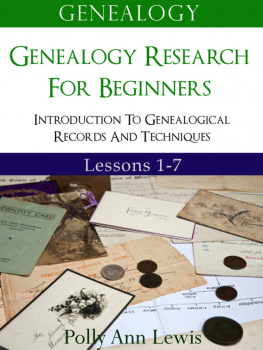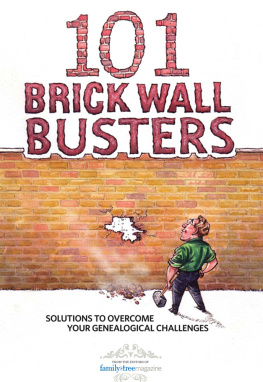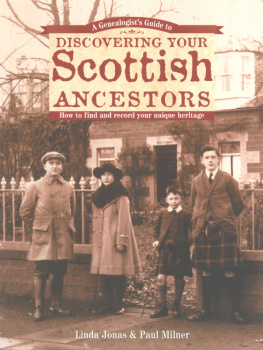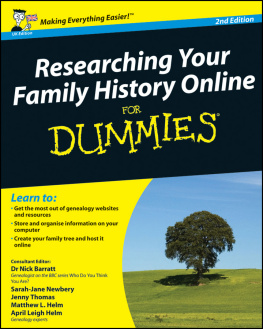
CONTENTS
I t is hard to believe that I have been teaching and writing about family history for nearly thirty-five years. Ive even managed to do a little of my own family tree. In that time Ive found that there are two types of family historians, those who are starting out and those who have gone beyond the basics.
There are lots of books catering for beginners, but rather fewer for those who are, for want of a better term, more advanced. Some tend to be semi-academic or rather dully written. Presumably the authors thought the subject was a serious one, which deserved serious treatment. Well I dont disagree at least up to a point. However, for heavens sake, why not try a livelier approach and inject some fun and fascinating facts?
When I edited Ancestors Magazine for The National Archives, we carried out research into why people werent buying the magazine. The greatest obstacle was that people thought it was for advanced family historians. Which was true, but what was worrying was that many of our readers had been doing their family history for years, but still believed they were beginners. In some cases they probably had forgotten more about the subject than I have ever learnt. Perhaps it was some sort of inferiority complex. Stuff and nonsense: you dont have to have a degree or diploma in the subject to be an expert.
So this book is not about the basics. If you are browsing in a bookshop wondering which book to buy for Auntie Beryl who has just begun the family tree, then much as I, and my publisher, would like to take your money there are better books out there, such as Karen Foys Family History for Beginners (The History Press, 2011). So we wont be considering the census or civil registration, except perhaps in discussing why they were established in the first place or looking at alternatives.
Nonetheless, if you, or Beryl, has an enquiring mind and wants to know more about your family tree and the huge array of records you can use to find out about the various branches then I hope this book is for you. In it Ill be pushing back the barriers, looking, for example, at new ways in which the internet can help your research, suggesting some unusual archives and records which might just transform your research, and looking at variants of family history around the world. Also, some of Britains top researchers will be contributing their thoughts about how to get the best from the resources at our disposal.
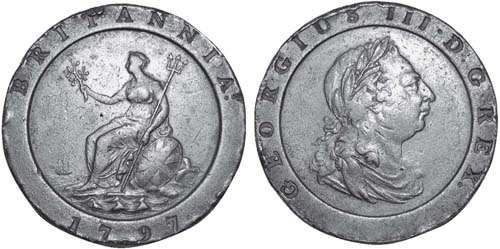
A cartwheel tuppence from the reign of George III. The penny and tuppence coins got their name from their size weight. (www.detecting.org.uk)
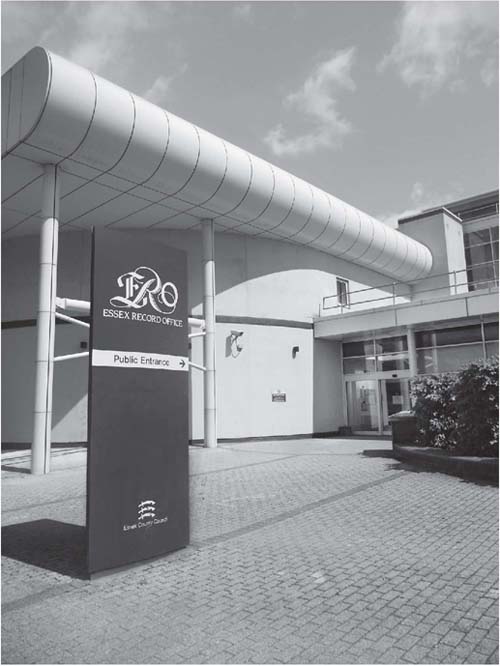
Essex Record Office is one of the many new county archives which have opened in recent years. (Authors collection)
Even so, I am very aware of the subjects that have not been covered, despite having written over 70,000 words. Some, like emigration and immigration, or records relating to the purchase, sale and ownership of land, are covered better elsewhere. I have also avoided extensive discussion about the army and navy, largely because I have written about their records elsewhere.
Surprisingly, finding anything about certain topics has proved almost impossible. Take jury lists, for example, which are often found with electoral registers. Many record offices have a selection of these records. What was the difference between the lists and the registers, and who was entitled to be a juror?
Family history is changing rapidly. New resources are released and new material digitised and placed online almost on a weekly basis. In addition, websites come and go. So far as I can make it, this book is accurate as of 15 August 2011. However, if the website has vanished, or the URL has changed, then Chapter 2 should be able to help.
I conclude, as Daniel Defoe did in his Tour Through the Whole Island of Great Britain, that all this relates to times past, and is an excursion which I shall atone for by making no more.
Thanks to the experts who contributed the short essays which are found scattered through the book: Dr Nick Barratt, Ruth Davies, Emma Jolly and Chris Paton. Thanks also to Gill Blanchard and Celia Heritage, to my editors Katharine Reeve and Lindsey Smith, and the team at The History Press for seeing the book through to print, and above all to my wife Sylvia Levi whose labours allowed me to write the book.
Of course, all errors and omissions are mine.
Simon Fowler
Kew, August 2011
Useful Information
This section contains information that will crop up throughout the book and is given here to avoid needless repetition.
Websites
To save constant repetition of URLs in the book here are the main ones you will come across time and again in the text.
| i. Commercial data providers |
| www.ancestry.co.uk | Ancestry |
| www.ancestry.com | Ancestry (US) |
| www.rootsweb.ancestry.com | RootsWeb |
| www.familyrelatives.com | Familyrelatives |
| www.findmypast.co.uk | Findmypast |
| www.thegenealogist.co.uk | TheGenealogist |
| www.genesreunited.co.uk | Genes Reunited |
| www.origins.net | Origins |
| www.scotlandspeople.gov.uk | ScotlandsPeople |
| ii. The National Archives |
| www.nationalarchives.gov.uk | The National Archives (TNA) main website |
| www.nationalarchives.gov.uk/documents online | DocumentsOnline |
| www.nationalarchives.gov.uk/a2a | Access to Archives (A2A) |
| www.nationalarchives.gov.uk/archon | ARCHON (database of almost all archives in the UK) |
| www.nationalarchives.gov.uk/nra | National Register of Archives (The National Archives wiki) |
| http://yourarchives.nationalarchives.gov.uk | Your Archives |
| iii. Other archives, museums and libraries |
| www.bl.uk | British Library |
| www.lma.gov.uk | London Metropolitan Archives |
| www.sog.org.uk | Society of Genealogists |
| iv. Other genealogy websites |
| www.cyndislist.com | Cyndis List |
| www.familysearch.org | FamilySearch |
| www.genuki.org.uk | GENUKI (UK and Ireland Genealogy) |
| v. Other websites |
| www.google.co.uk | Google |
| http://en.wikipedia.org | Wikipedia |
Money
Almost nobody under the age of 50 can remember Britains pre-decimal currency. However, as you will find figures in a wide range of documents it can be useful to know a bit more about it. Before February 1971 the pound was divided into shillings and pence. There were 20 shillings to the pound and 12 pence to the shilling (or 240 pence in a pound). The pound was often abbreviated as l for libra (or pound in Latin), the shilling as s (Latin soldus) and penny as d (Latin denari). In addition, there were a number of other coins, including the guinea (21s or 1 1s), mark (8s 4d), crown (5s), half-crown (2s 6d), florin (2s), groat (4
Next page
